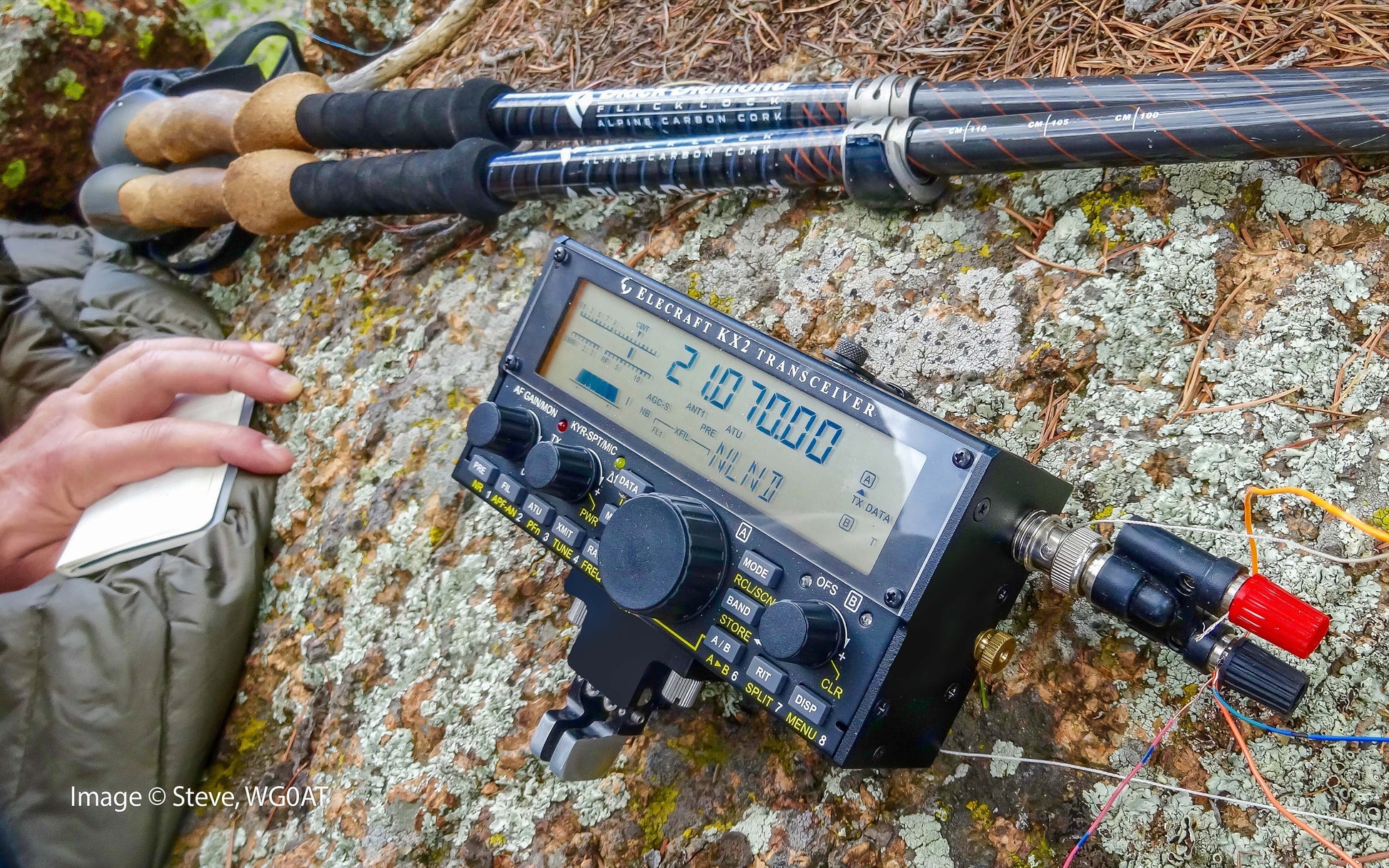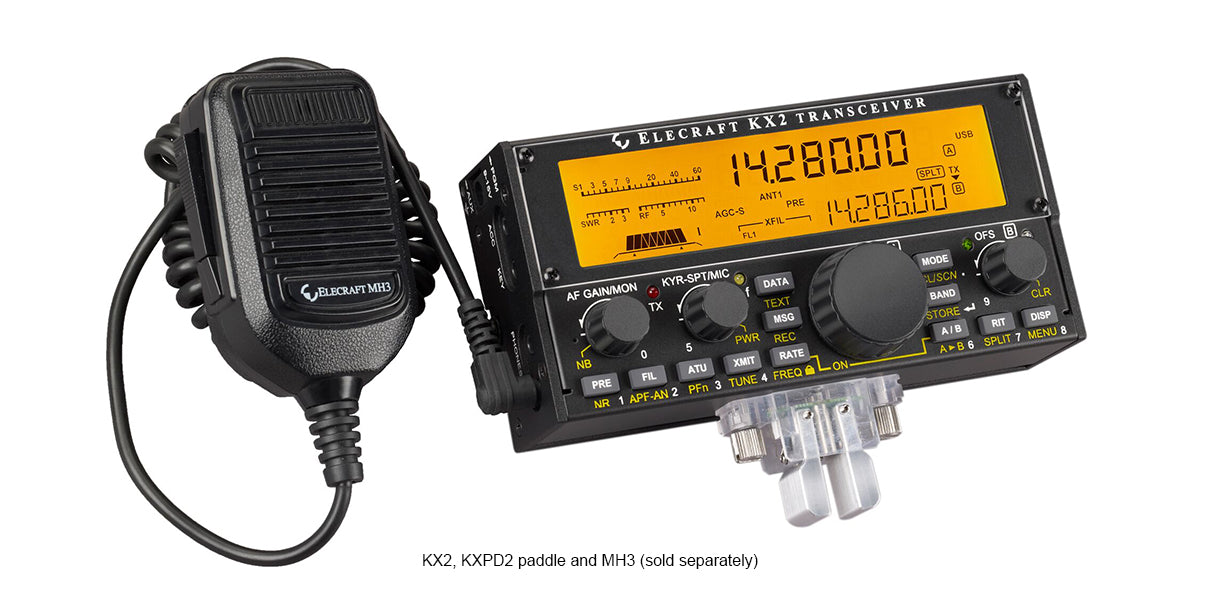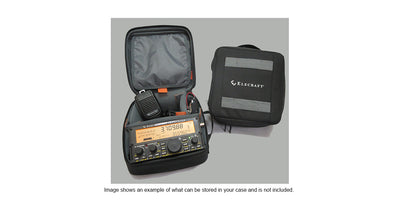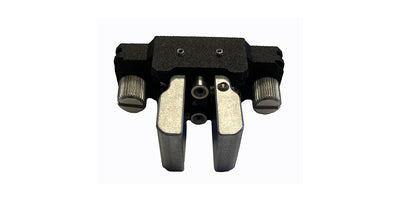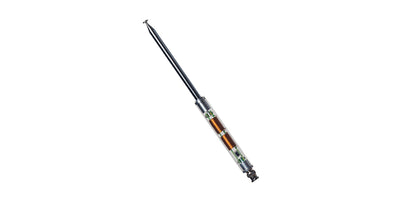KX2 TRANSCEIVER
An 80-10 m SSB/CW/Data station that fits in your pocket!
Note: Paddle in picture is not included. May be purchased under Options/Accessories.
NEW! KXIBC2 Internal Battery Charger for the KX2The KXIBC2 module is a C/10-rate charger for the KXBT2 Li-ion internal battery pack. Operation is simple, requiring only that a power supply be connected to the KX2 when charging is required. The radio may be on or off during charging. The KXIBC2 does not generate any RFI, so the radio may be used during charging if the power supply provides sufficient current for both charging and receive/transmit operation. The KXIBC2 replaces the previous KXI02 option module, retaining its RTC (real-time-clock) function. You cannot have both options in the radio; they physically fit into the same space. Learn more below, under Options/Accessories. |
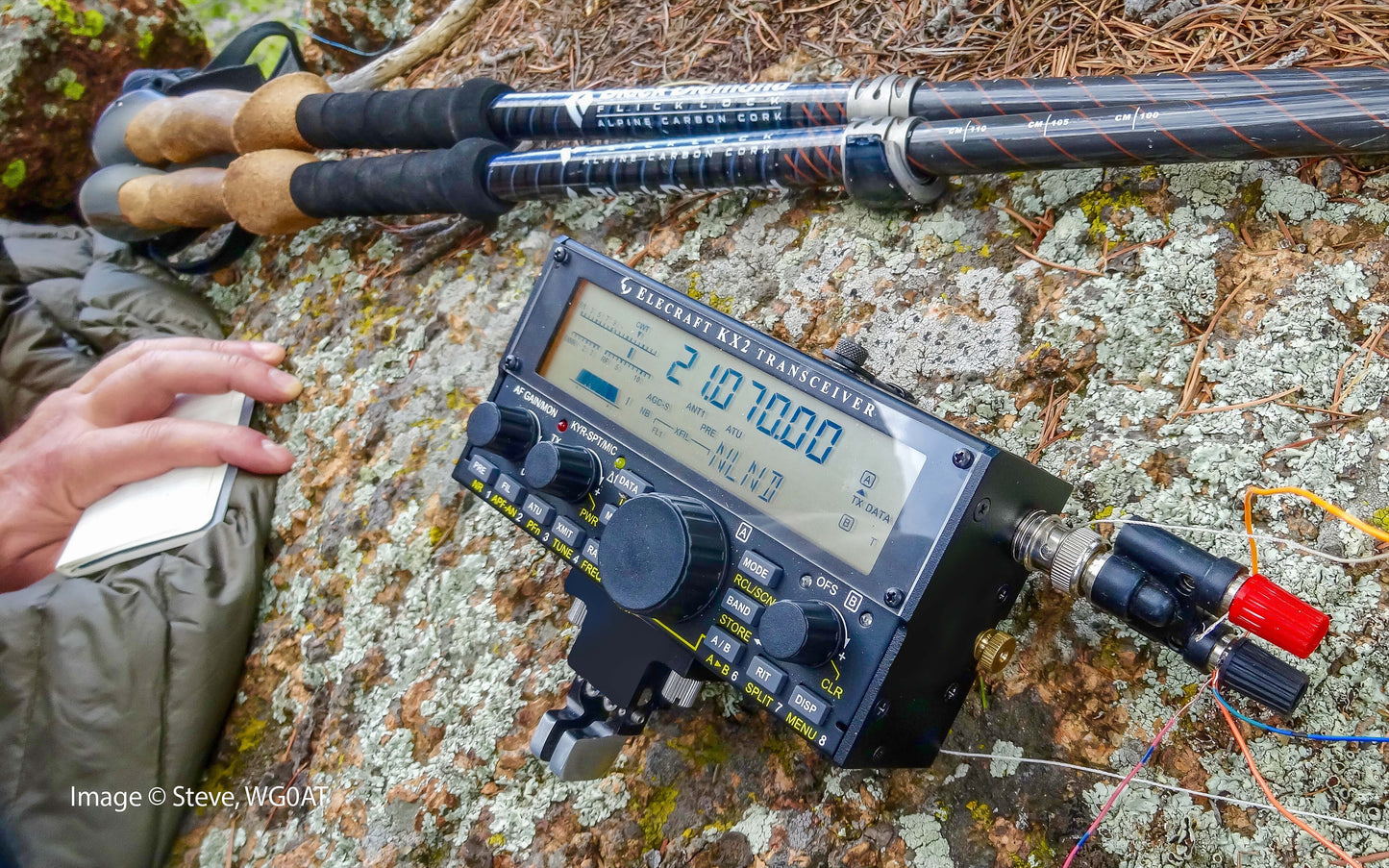

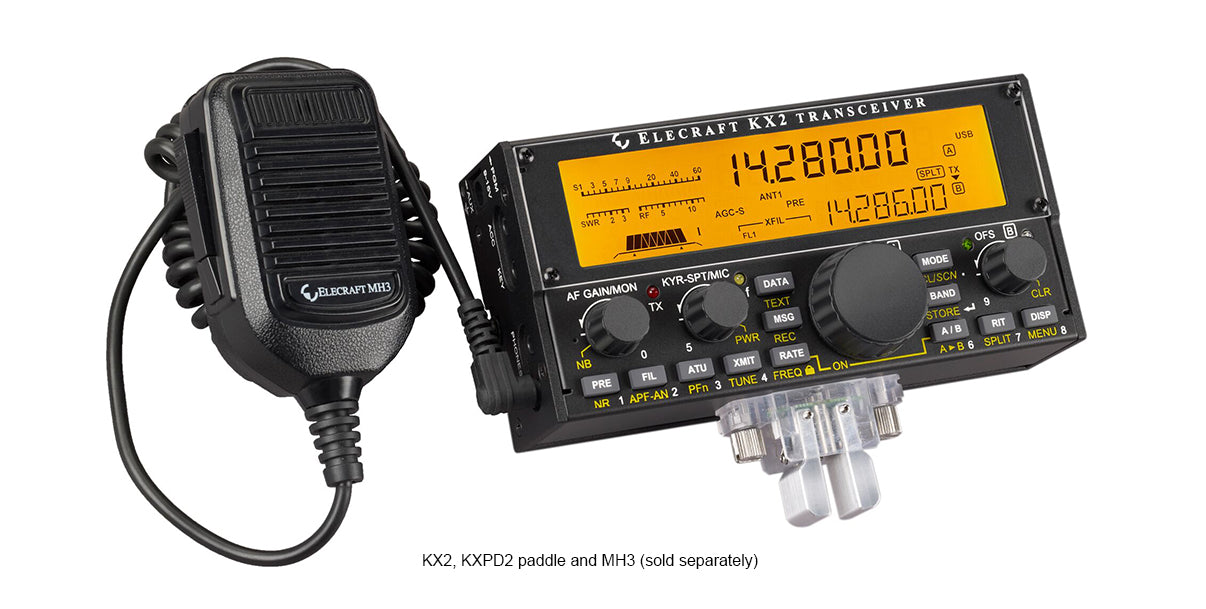

- Overview
- KX2 Pack
- Specs
- Options/Accessories
- Reviews & Articles
- FAQ
- Manuals
- Price List/Order
Overview
Our KX2 “stealth” transceiver can go wherever your imagination takes you. Thanks to state-of-the-art construction techniques, it’s only 5.8 x 2.8 x 1.5” and weighs just 13 ounces—making it the smallest full-featured HF radio on the planet. Yet it puts out up to 10 watts, covers 9 bands, and shares many features with the KX3. It also works with the KXPA100 amplifier. To maximize your freedom to roam, you can outfit your KX2 with an internal 2.6 amp-hour Li-ion battery. Current drain is as little as 135
KX2 vs KX3: Which one should I buy? Learn More
KX2 Shack-In-A-Box
|
| Package Savings! |
Specs
- Only 13 oz. (0.3 kg) – ideal for portable and hand-held operation Internal 2.6 Ah, 11 V Li-ion battery option
- Internal wide-range ATU option
- Current drain as low as 135 mA Built-in microphone and speaker
- Advanced DSP provides dual watch, noise reduction, noise blanking, autonotch, stereo audio
- Versatile software-defined radio (SDR) architecture
- Operates in data modes (PSK31/RTTY) with or without a PC
Standard Features
- 80-10 meter ham bands; general coverage receive from 3-32.0MHz (also covers 0.5 to 3 MHz with reduced sensitivity)
- All modes: SSB, CW, and Data (four sub-modes)
- Ultra-compact size: 2.8”H x 5.8”W x 1.5”D; 13 oz (less options); low-profile knobs and feet for minimum height
- Rear tilt foot provides 3-point mount for rugged terrain
- Custom high-contrast LCD with alphanumeric text display
- Current drain as low as 135 mA in receive mode
- High-performance 32-bit floating-point DSP
- Built-in PSK/TTY decode/encode allows data mode operation without a PC; transmit in data modes using CW keyer paddle
- Synthesizer has 1-Hz tuning resolution
- Integrated numeric keypad for direct frequency entry
RECEIVER
- Software-defined-radio (SDR) architecture for versatility
- Switchable preamp and attenuator
- 8-band RX EQ
- Simultaneous dual receive over up to +/- 23 kHz for split-DX operation
- Built-in speaker; stereo jack for headphones or powered speakers
- Easy-to-use Passband Tuning (PBT) for shift/width/hicut/locut; roofing filters automatically track DSP filter settings
- Auto-notch removes interfering carriers; adjustable noise reduction and noise blanking; stereo audio effect
- Center-tuning indicator for CW and data modes; auto-spot
TRANSMITTER
- Up to 10 W on 80-15 m, 8 W on 12 and 10 m (typ.)
- 100 W with KXPA100 amplifier
- Rugged, SWR- and temperature-protected final amplifier stage
- Use with built-in mic or MH3 (with UP/DN VFO functions)
- CW keyer with 8-50 WPM range; fast, full-break-in keying
- Built-in digital voice recorder (DVR) with 2 message memories
- Three CW/DATA message memories
- Fast, silent, PIN-diode T-R switching – no noisy relays
- DSP speech processing for excellent “punch”
- 8-band TX EQ tailors passband to your voice and microphone
Additional Features
- General-purpose and per-band memories store VFOs, modes, etc.
- Computer control via supplied USB or RS232 cable
- Free firmware updates via provided application software
- Programmable switch (PFn) for access to an often-used menu entry
- Full remote-control command set works with popular computer software applications
- Selectable switch-press tones or full Morse code-based interface
- Tutorial-style manual ideal for new hams
Options
- KXAT2 Internal, Wide-Range Automatic Antenna Tuner
- NEW! KXIBC2 Internal Battery Charger
- KXBT2 Lithium-ion Battery Pack; 11 V, 2.6 Ah.
- KXBC2 External Lithium-ion Fast-Charger for KXBT2 Battery Pack
- KXIO2-F_Real-Time Clock and General-Purpose Outputs Installed
|
New shipping regulations for Lithium Ion Batteries Until further notice, we are currently restricted to shipping up to 3 KXBT2 batteries in a single shipment, with one of the three batteries inside a KX2 - this is for both US and international shipments. We cannot ship Lithium Ion Batteries to the following countries: Australia, Japan, Spain and Thailand. Battery orders alone can only be shipped UPS Ground - US only. |
Accessories
- KXPD2 Attached Precision Keyer Paddle
- CS40 Compact Padded Carrying Case accommodates a wire antenna, paddle, log, and small accessories.
- ES60 is a larger carrying case that will accommodate all items in a CS40, plus an MH3 mic and more accessories.
- MH3 Hand Microphone
- Proset Boom Headset
- SS30DV Compact Switching Power Supply
- KX2GNDPLUG Mini Banana Plug
- BNC-BP Post Adapter
- BNC-RA Male-Female Right Angle BNC
- BNC-UHF Adapter
- AX1 Multi-Band Whip Antenna
- AXE1 40M Antenna Extender for the AX1 Whip
- AX2 Minature 20-Meter Whip Antenna
- E770064 13' ground wire with lug
- E770091 33' ground wire with lug
Books
Parts & Mod Kits for the KX2
Reviews & Articles
- KX2 eHam Review
- QRZ.com KX2 Review
- KX Line on Ormes Peak - SOTA
- Backpacking with a Pocket-sized Shortwave Radio, Bruce Prior N7RR
FAQ
Q: What is the KX2?
A: The KX2 is a pocket-sized, all-HF-band, SSB/CW/data transceiver intended for field, mobile, and even hand-held operation. It's the world's smallest full-featured amateur radio transceiver, complete with 10 watts output, a large, easy-to-read display, and built-in battery and antenna tuner options. The KX2 is also a true SDR (software-defined radio), with full 32-bit IF DSP. This unique combination of small size and versatility make the KX2 a great grab-and-go radio for any outing.
Q: Why is the KX2 only offered factory assembled?
A: The KX2 is the smallest full-featured, all-HF-band transceiver available. To achieve this level of miniaturization, we used a variety of high-density, state-of-the art packaging techniques. As a result, some of the hardware and connectors are small enough to be difficult for some potential kit builders to handle.
Q: How does the KX2 differ from the KX3?
A: The KX2 has many of the same features as the KX3, but it's about half the size and weight, making it ideal for ultra-light portable and "stealth" operation. It covers all HF bands (80-10m), with SSB, CW, and data modes, with up to 10 W output from its internal Li-ion battery. Controls are lower in profile. There's a single tilt-foot in the rear, making a 3-point mount for rugged terrain. The built-in mic and quick-disconnect trailing ground wire are ideal for hand-held operation.
The KX3 has additional features that make it the choice of many operators as a home, travel, and DXpedition station. These include 160-6 meter coverage, a 2 or 4-meter VHF option, full 15 watt output on most bands, ultra low-noise synthesizer, larger complement of controls, weighted VFO A tuning knob, and matching high-performance panadapter (PX3).
Both rigs work seamlessly with the KXPA100 amplifier. They also share the MH3 microphone, KXPD2/KXPD3 keyer paddles, and other accessories.
Q: How does the KX2 differ from competing small radios?
A: There are several factors that differentiate the KX2 from others. First, there's its level of integration. Despite its small size, the KX2 can be configured as a complete station, with a built in wide-range ATU, high-capacity internal battery, attached keyer paddle, and realtime clock (on the KXIO2 option module). This means less additional equipment to carry for a field outing. It's like having a full desktop transceiver system in the palm of your hand.
Second, the KX2 makes very frugal use of its internal battery compared to other DSP-based radios. Receive current drain is as low as 135 mA (backlight and preamp off). The key to this is the use of cascaded, high-efficiency, low-noise DC-to-DC converters. This low current drain allows you to operate for an extended period - from 4 to 10 hours, depending on transmit power level and duty cycle.
There are other important differences. For example, with the KX2 you'll rarely need to use the menu, since controls that get the most use are always available. You'll be able to use the radio in direct sunlight, thanks to its high-contrast, full-custom, transflective LCD. You'll also have clean, crisp filtering, T/R switching, and excellent signal integrity. Your KX2 will sound great on the air, no matter how challenging the operating situation.
Q: Is the KX2 a good choice for first-time HF operators?
A: Yes, for several reasons: First, the basic 10-watt KX2 packs nearly all of the features of a traditional desktop radio into a low-cost package, making it more affordable while not sacrificing versatility. The user who needs full power (100 W) can easily add a KXPA100 later on, if desired; this can improve your signal by about two S-units of signal strength at receiving stations.
Second, the KX2 is very easy to use, with about one-third as many controls as our top-ofthe-line K3S transceiver. We distilled the panel controls down to those most needed for typical operation, while retaining some additional advanced features as menu selections. The tutorial-style owner's manual provides explanations of both how these controls can be used, and why you might want to use them.
Finally, the KX2 is fun to operate-from anywhere. At under one pound, it can inspire firsttime HF users to go beyond their home station, enriching outdoor activities and turning vacations into mini-DXpeditions. The KX2 is also a very capable radio for mobile use, an application many hams discover as they get into the hobby.
New operators will also benefit from Elecraft's outstanding user forum, where they can feel comfortable asking questions on any amateur radio subject.
Q: Can I use the KX2 with SDR (software defined radio) applications and the PX3 panadapter?
A: No. The KX2 is a true SDR, architecturally, but we kept its size, weight, and current drain low by emphasizing features needed during field operation. Panadapters and laptop computers add a lot of extra weight, and are typically considered part of a home station. For this reason we did not include external RX I/Q interface circuitry in the KX2. (However, we offer two other transceivers that have high-performance panadapter options: the K3S with P3 panadapter, and KX3 with PX3 panadapter.) Of course you can connect the KX2 to a computer sound card for use with data-mode communications packages, via the mic and headphone jacks.
The KX2 also includes two built-in data modes (PSK-D and FSK-D) so you can operate in those data modes without a computer. In these modes, text is displayed on the VFO B display as it is decoded, and CW sent with the built-in keyer is automatically converted into PSK31, PSK63, or RTTY signals.
Q: Are there unique applications where the KX2 works best? When would I use a KX3?
A: Refer to the selection guide below.
| KX2 | KX3 | |
| Hand-Held, Pedestrian Mobile (/PM) |  |
|
| Ultra light Backpacking |  |
|
| SOTA (Summits on the air) |  |
 |
| Lowest-Cost All-HF-Band Station |  |
|
| High-Performance Contesting |  |
|
| 160 Meters: AM Broadcast DXing |  |
|
| Home Station with Panadpter (PX3) |  |
|
| All-mod VHF (6 m included; 2 or 4 m optional) |  |
|
| Mini-DXpeditions, Travel, RV |  |
 |
| Camping trips, day hikes, Field Day |  |
 |
| Mobile (100-W with KXPA100 ampP |  |
 |
Q: It the KX2 a good choice for SOTA (summits on the air) operation?
A: Yes. We designed the KX2 specifically with SOTA operators in mind. At just 13 ounces (less options), the KX2 should fit into the weight budget for nearly any field excursion. Yet it provides more features, better ergonomics, and higher power output than minimalist radios. For weak-signal receive, there's DSP-based APF (audio peaking filter), noise blanking, and noise reduction. The speaker has plenty of volume to overcome wind noise. In transmit mode, you'll have 3 programmable message buffers for both CW and data, and a 2-memory digital voice recorder for SSB.
The KX2 is also ideal for use in difficult operating conditions. While standing, it can be held like an HT, with the built-in mic and keyer paddle just where you need them. In a pinch, you can make plenty of QSOs using a telescoping whip. If you're sitting on the ground or on a rock, you'll find the KX2 works very well in TFR (trail-friendly-radio) mode, with its folding tilt-foot deployed.
For logging, you may want make use of the KX2's two utility mounting points (4-40 PEM nuts) on the bottom cover. You can even use these to attach the KX2 directly to a clipboard.
Q: How does the KX2 compare to the KX3 on a feature by feature basis?
A: The KX2 retains many of the best features of the KX3 in a smaller footprint. Here's a quick overview.
| KX2 | KX3 |
| Bands | 9 (80-10 m) + gen. coverage | 11 (160-6 m) + gen. coverage |
| VHF option | n/a | 2 m or 4 m; separate VHF antenna connector |
| Modes | CW, SSB, PSK31/63, RTTY, AF data | CW, SSB, PSK31/63, RTTY, AF data, AM, FM |
| Size (less projections) | 25 cu. in. (1.5x2.8x5.8") | 45 cu. in. (1.8x3.5x7.4") |
| Weight (less opt. & batt.) | 13 oz. | 24 oz. |
| Max power output | Up to 10 W | Up to 15 W |
| DSP Filtering | 50-4000 Hz, + passband shift | 50-4000 Hz, + passband shift |
| Roofing filter option | n/a | 1.0 kHz (CW)/3.0 kHz SSB(KXFL3) |
| Controls | 12 switches, 4 knobs | 20 switches, 5 knobs; 1 optical encoder with weighted knob |
| Display | Transflective LCD w/backlight | Transflective LCD w/ backlight |
| Main tuning encoder | Mechanical, sleeve bearing | Optical, with ball-bearing shaft and weighted knob |
| Internal speaker | 0.5 W peak | 1 W peak |
| Mic | Built-in mini-mic or MH3 | MH3 |
| Internal ATU option | 7L/7C network (KXAT2) | 8L/8C network (KXAT3) |
| Keyer paddle options | External or KXPD2 | External, KXPD2, or KXPD3 |
| Internal battery and charger | Internal 11 V Li-ion battery option (KXBT2) and external charger (KXBC2) | 8 x AA socket included; optional internal NiMH charger |
| PX3 interface | n/a | Built in |
| Real-time clock | Supplied with KXIO2 option | Supplied with KXBC3 option |
| Additional hardware features | Mini-banana jack for quickdisconnect ground wire; very easy battery pack swap; built-in mic for emergency/hand-held use; 2 general-purpose opendrain outputs (on KXI02 option) | Matching PX3 panadapter, ultra low-noise synthesizer, 10/20/30 dB preamp per-band, local oscillator isolation amp, PTT/TX-inhibit input, dedicated filter control, VFO reverse, remote power-on via mic jack, high-efficiency QRP TX mode |
| Common Firmware features (KX2 and KX3) | 32-bit DSP/SDR architecture with dual watch, stereo audio, dual VFOs, split, RIT, scanning, direct freq. entry, CW and data text encode/ decode, DSP NR/NB/auto-notch, 100+ freq. memories, CW/data messages, voice messages (DVR), auto power-off timer, RX/TX EQ, XVTR band displays | |
| Additional firmware features | Amp-hours display for battery monitoring/testing | 2 programmable switches w/macro capability, wake-up alarm, manual notch filter, ESSB, 1-tap message play, remote control of other radios, pitch-map audio effect, repeater control |
Q: What does the KX2 control panel look like?
A: Here's a quick view of the front panel controls. Note that the buttons still use the familiar Tap or Hold functions for access to the most-used features.
Additionally, there is a Menu system for tailoring the KX2 operating settings to the operator's preference. Most of these need only be set up one time.

Q: What does the KX2 control panel look like?
A: Here's a quick view of the front panel controls. Note that the buttons still use the familiar Tap or Hold functions for access to the most-used features.
Additionally, there is a Menu system for tailoring the KX2 operating settings to the operator's preference. Most of these need only be set up one time.
Q: What kind of connections will the KX2 provide for peripherals?
A: The left side has a series of jacks, described below.

- ACC: Contains the RS232 TX/RX signals and the KEY OUT signal to connect a linear amplifier such as the KXPA100.
- KEY: Allows you to connect a keyer paddle, keyer (or other keying device), or a straight key. There is a menu item to configure it for the device type used.
- PHONES: Stereo audio output for use with headphones or a set of powered external speakers. The Dual Watch feature uses the stereo outputs to allow you to operate as if there were two receivers, one on the frequency of VFO A, the other on VFO B.
- MIC: Input for a hand mic (such as the MH3) or a desk or boom mic. Bias is available for those mics that need it. The MH3 includes UP/DN buttons for mobile VFO tuning.
- 9-15VDC: DC input jack for use with a KXBT2 Li-ion battery pack or other power source. There's an identical DC jack inside the KX2 for use with the KXBT2. If both an internal battery and external power source are plugged in, the radio operates from whichever has the higher voltage.
- AUX: This jack is actually on the rear of the KX2. It provides two general-purpose outputs that can be programmed on a per-band basis to control external equipment such as an antenna switch or transverter.
- Grounding point: Intended for attaching the KX2 to other peripherals and to station ground. The connection point is sized to use a Mini-Banana plug (Elecraft model KX2GNDPLUG). This is ideal for use with a trailing ground wire during pedestrian mobile operation (/PM). If you step on the wire, the plug will pull out easily, avoiding damage to the KX2.
Q: How do I connect an antenna?
A: On the right side of the KX2, there's a BNC connector for the antenna. Wire antennas can be connected using our BNC-to-binding-post adapter (BNC-BP).

Q: Performance-wise, how does the KX2 stack up to other radios?
A: Here are the KX2 Specifications:
| General Specs | |
|---|---|
| Frequency Range | Receive, 500 kHz - 32 MHz. See 500 kHz to 3 MHz sensitivity note below. Transmit, 80/60/40/30/20/17/15/12/10 meter ham bands. (Consult factory for MARS or other non-ham-band coverage.) Transmit excluded in some ranges (by country). |
| Frequency Stability | +/- 1 ppm typical at 25 C after 5-minute warm-up. |
| Antenna | 50 ohms, BNC |
| Modes | USB, LSB, CW, DATA; built-in text encode/decode for CW/PSK/RTTY modes |
| VFOs | Dual VFOs; 150+ frequency memories; scanning/channel hopping |
| Accessory I/O |
ACC jack: RS232 or USB port depending on selected adapter. Keyline: 30 V max. AUX 1 and 2 jacks (KXIO2 option): Open-drain outputs; 28 V, 150 mA max. |
| Supply Voltage and Current | 8 V min, 15 V max. 1 to 2 A typical in transmit; 150 mA typical in receive (backlight off, preamp off, no signal). |
| Size and Weight | Size, less projections: 2.8 x 5.8 x 1.6" (5 x 14.7 x 4 cm); weight, less battery or options: 13 oz. (0.37 kg) |
| Receive | |
| Sensitivity(MDS), 500-Hz bandwidth | -136 dBm (typ.), preamp on. Note: Sensitivity rolls off significantly below 3.0 MHz due to protective high-pass filtering. Preamp-on MDS is typically -105 dBm at 1.5 MHz, and -80 dBm at 1.0 MHz, sufficient for emergency AM broadcast signal copy. |
| Image and I.F. Rejection | 55-70 dB typ. From 3 to 32 MHz (varies with filter settings, mode, and band). Image rejection from 0.5 to 3.0 MHz is not specified. |
| Audio Output | Internal speaker, 0.3 W typ.; headphones/ext. speaker jack, 0.1 W/channel (stereo) |
| Receive Features | 8 band RX EQ, tunable I.F. passband width/shift, audio peaking filter (APF), noise reduction, noise blanker, automatic notch filter |
| Transmit | |
| Output Power | 80-17 meters, 10 W PEP max (+/- 1 dB); 12 and 10 meters, 8 W PEP max (+/- 1 dB). Recommended transmit duty cycle: 50%, all modes. (If power amplifier temperature or current drain is too high, power will automatically be reduced.) NOTE: When using over 5 W in SSB, DATA-A and AFSK-A modes, the recommended supply voltage is 12 V or higher to minimize transmit intermodulation products. Higher power with lower voltages should be used only when necessary. |
| Internal ATU (KXAT2) | 7 L/7 C network; matching range typ. 20:1 or higher. Rated power: 15 W. Insertion loss (bypass mode): < 0.5 dB. |
| Transmit Features | Speech compression (I/Q baseband envelope clipping); 8-band TX EQ; VOX; full and semi CW break-in with adjustable delay; diode T/R Switching; 3 DATA/CW messages and 2 SSB (DVR) messages |
| Carrier Suppression | > 50 dB typ. |
| Harmonic / Spurious Outputs | > 50 dB below carrier typ. @ 10 W |
| CW Sidetone/Transmit offset | 400-800 Hz, adjustable (receive filter center frequency tracks sidetone pitch) |
Q: Does the KX3 stay in the product lineup now that the KX2 is shipping?
A: Yes, it does. The KX2 and the KX3 are different products to serve different purposes. The KX2's size and weight make it perfect for SOTA and field ops. It fits in your pocket or carrying pouch. The KX3 has more bands, more modes,
Q: Now that there's the KX2, will there be continued enhancements for the KX3?
A: Yes. Elecraft will continue to produce, support, and enhance the KX3-the other transceiver in our KX Line. The KX3 has features not present in the KX2, including support for our full-color panadapter (PX3), coverage of all bands (160-6 m), all modes (adds AM and FM), higher power (15 W), a 2 or 4-m option, and more controls (including weighted VFO knob).
KX2 Options
Q: What cables and accessories come in the box with the KX2?
A: Power cable (E850524), KXUSB Computer interface cable, and Owner's Manual.
Q: What are the options for the KX2?
A: Here's an overview of the options:
| Option | Description | What do I need to order? |
|---|---|---|
| MH3 Mic | The MH3 microphone includes a high-quality element, space-saving right-angle plug, PTT switch, and VFO UP/DN function buttons. | MH3 |
| KXPD2 Keyer Paddle | The KXPD2 is a very compact mechanical keyer paddle that attaches directly to the front of KX2 (or KX3). This eliminates the need for a heavy keyer base. It includes a slot in which to store the contact-adjustment wrench. | KXPD2 |
| CS40 and ES60 Padded Cases | These padded cases will protect your KX2 and accessories during transport. The CS40 is just right for carrying the KX2, a wire antenna, earbuds, log sheet, keyer paddle (e.g. KXPD2), and other small items. The larger ES60 can also accommodate an MH3 microphone and larger antennas or accessories. | CS40 or ES60 |
| KXIO2 RTC & Aux. Outputs | The KXIO2 option provides a real-time clock and two user-programmable outputs (AUX jack). The time can be displayed in the KX2's VFO B area and the TIME menu entry). Time accuracy can be fined-tuned to about +/- 2 seconds per day using the RTC ADJ menu entry. The two AUX outputs can be used for controlling per-band external equipment such as an antenna switch or transverter (see the AUX 1 and AUX 2 menu entries). | KXIO2 |
| KXAT2 Internal ATU (Antenna Tuner) | With a KXAT2 automatic antenna tuner (ATU) installed, you can use non-resonant and narrow-band antennas. Such antennas are very convenient for field operation. An ATU can improve transmit power transfer and receive sensitivity. | KXAT2 |
| KXPA100 Integrated 100-W Amplifier | The KXPA100 is a rugged 100-W, 160-6 m amp that can be used with the KX2, KX3, or any other QRP transceiver. An internal 100-W ATU is also available for the amp (KXAT100). The KX2 can remotely tune the 100-W ATU and control its antenna switch (MENU:ANT.X SW). A KX2 Accessory Cable (KX2ACBL) is required to split the KX2's ACC jack into two jacks: KEY OUT (2.5 mm) and serial I/O (3.5 mm). | Required
|
| KXBT2 Internal Li-Ion Battery Pack | The KXBT2 battery pack weighs about 4.8 oz, and can provide up to 8 hours of typical transceiver operation and up to 10 W power output. You can plug in an internal battery and an external supply at the same time, and the radio will operate from whichever is higher in voltage. | KXBT2 |
| KXIBC2 KX2 Internal Battery Charger | The KXIBC2 module is a C/10-rate charger for the KXBT2 Li-ion internal battery pack. Operation is simple, requiring only that a power supply be connected to the KX2 when charging is required. The radio may be on or off during charging. The KXIBC2 replaces the previous KXIO2 option module, retaining its RTC (real-time-clock) function. | KXIBC2 |
| KXBC2 Battery Charger | This charger is designed specifically for use with our KXBT2 Li-ion battery pack. It can safely charge the KXBT2 in 1 to 3 hours. Note: To charge the battery, you must first remove it as described in the KX2 owner's manual. It cannot be charged while inside the radio. The power jack on the left side panel is isolated from the internal power jack, and cannot supply power to the battery. | KXBC2 |
| KX2GNDPLUG | A mini-banana plug specifically designed for use as part of a trailing counterpoise wire in /PM operation. | KX2GNDPLUG |
| KX2ACBL | Used to break out the computer control and key out signals separately. These can then be connected to an Elecraft KXPA100 amplifier via its adapter cable. | KX2ACBL |
Q: How is the KXPD2 different from the KXPD3?
A: The KXPD2 keyer paddle mounts directly to the front of the KX2 (or KX3) with two thumb screws. It's about 33% shorter than the KXPD3, requiring less space in a small bag such as our model CS40 (see above). The KXPD2 also includes a storage slot for the allen wrench used to adjust the contacts, allowing convenient field adjustment.
Q: Can I use a KXPD3 with the KX2?
A: Yes; however, you may need to update the KXPD3. If your KXPD3 has one thumb screw that's longer than the other, order part no. E700245 to replace the original left-hand thumb screw on the KXPD3. Use of the original longer thumb screw would damage the KX2.
Q: Does the KX2 provide a way to plug in my own key?
A: Yes, there's a separate input jack on the left side for your paddle, bug, or straight key.
Q: Are the KX2's internal options usable with a KX3?
A: No. A new family of options has been designed specifically for the KX2. All of them are available immediately with the KX2's introduction. (All options for the KX3 remain available, with no changes as a result of the KX2's introduction.)
KX2 Li-Ion Battery and Charger FAQ
Q: How does the KX2's internal battery system differ from the 8-AA pack used in the KX3?
A: The KX2 uses our KXBT2 internal battery option, a fully sealed and electronically protected lithium-ion battery pack. The KXBT2 can be plugged in either internally or externally to the transceiver. It is fitted with a 2.1mm ID/5.5mm OD plug. The pack is installed in the KX2 by opening the bottom cover as shown in the next illustration.

Q: Does the KX2 have an internal battery charger?
A: Yes: The KXIBC2. This internal charger works with or without the KX2 turned on, generates no RFI, and includes the same real-time clock functions as the KXIO2. It can charge the internal battery from any small external power supply, battery, or solar panel. For a full charge, the external source should provide 13.5 to 15.0 V, though voltages as low as 12 V can provide a useful amount of recharge.
Q: What AC cable is shipped with the KXBC2 and will it work on both 120V/240V AC?
A: The KXBC2 battery charger will ship with an AC cable for use in the U.S. It will work on both 120V and 240V AC systems for worldwide operation. If you need to operate the KXBC2 in other parts of the world, you may order international AC cables from Elecraft.
Q: May other battery chargers be used with the KXBT2?
A: No. Elecraft provides two complete solutions for using and recharging the KXBT2 - the KXIBC2, Internal Battery Charger and/or KXBC2 External Battery Charger. Specific voltage, current, and temperature limits are enforced to ensure safe operation. We do not recommend alternative methods of recharging the KXBT2.
Q: Can the KX2 be operated without its internal battery installed?
A: Yes. You can operate the KX2 from an external power source. The recommended supply voltage for full power output is 12 to 14 V, although the KX2 will reach a full 10 watts on most bands using the KXBT2 (11 V). If you have both an internal battery and an external source connected, the KX2 will be powered by whichever has the higher voltage.
Q: Can the KXBT2 be recharged while it installed in the KX2?
A: Yes, using the KXIBC2 charger (see above).
Q: In addition to the Li-Ion type battery, may other types of batteries be used with the KX2?
A: Any type of battery may be used to power the KX2 externally. However, the internal battery compartment is specifically designed for use with the KXBT2. Smaller batteries may fit, but are not likely to provide much operating time. The KXBT2, at 2.6 amp hours, allows from 4 to 8 hours of typical transceive operation, depending on transmit power level.
Q: Will the KXBT2 battery fit inside the KX3?
A: No. The dimensions of the KXBT2 will not allow it to fit inside the KX3, even if its AA battery holders are removed. The KXBT2 can, however, be connected to a KX3 externally and will operate the KX3 at up to 10 W output. The KXBT2 will also power most devices rated for 9 to 15 volts, including our other small transceivers, PX3 (matching panadapter for the KX3), and XG3 signal generator.
Q: What benefit does the KXIBC2 provide?
A: KX2 owners who have installed the KXIBC2 have told us they love the convenience of simply plugging in their regular power supply to charge the internal battery pack. The charger operates with or without the radio turned on, and the process is fully automatic, so your KX2 will be ready to go whenever you are. Of course, you can still use the fast charger if you're in a hurry.
Q: How hard is it to install the KXIBC2 module?
A: Anyone with a modest amount of soldering experience should be able to do the KXIBC2 installation. Based on lots of feedback from field testers, we dramatically simplified the installation procedure. For field installation, we recommend "Method 1" (see the revision B2 instruction manual or later). There's no need to do any disassembly other than removing and replacing the right side panel. And there are only two wires to solder. If after having a look at the instructions you feel that you'd rather let Elecraft to the job, we'll be happy to. Simply contact support@elecraft.com to obtain an RMA.
KX2 support for KX-Line products and peripherals
Q: May I add the KXPA100, 100-watt linear amp to a KX2 for full 100 watt operation?
A: Yes, you can. Please see option chart earlier in this FAQ for ordering information.
Q: Will I be able to use the KX2 as a Remote Control device with any Elecraft radios?
A: Not at this time.
Q: Will the K3/0 Mini and Remote system work with the KX2?
A: No. Elecraft K3 Remote System products support the K3S and K3 only.
Q: Can I use the MH3 microphone with the KX2?
A: Yes. The MH3 has a high-quality mic element and works very well with the KX2.

